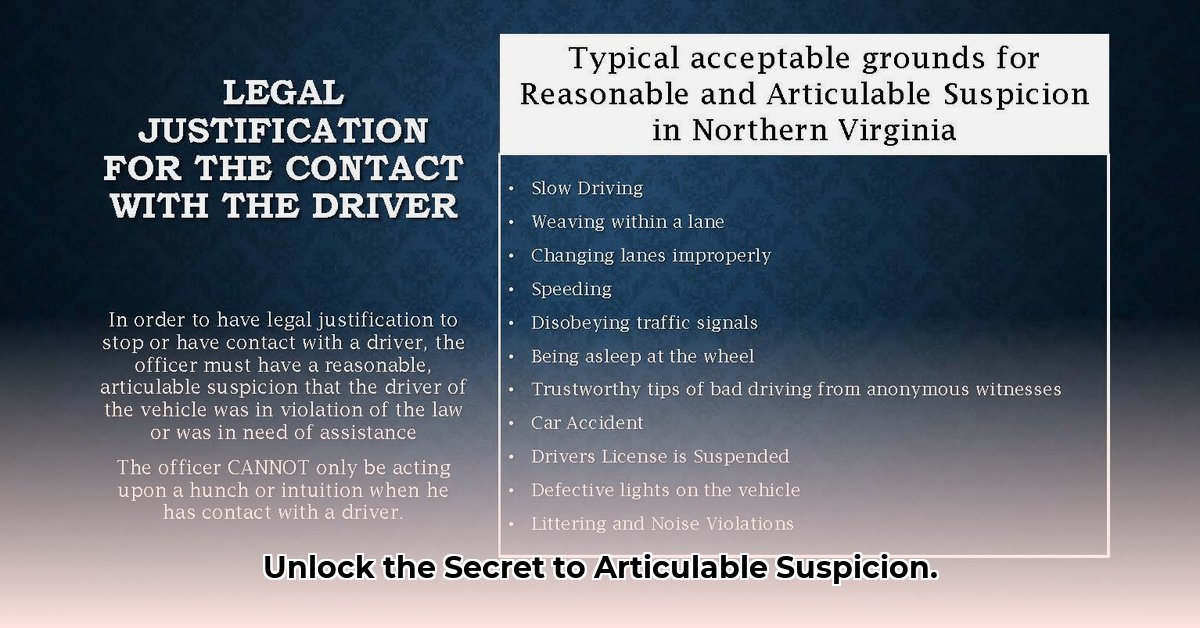
Understanding articulable suspicion is crucial for law enforcement, legal professionals, and the public. This guide provides a comprehensive explanation of this legal concept, differentiating it from probable cause and outlining best practices for its application.
Articulable Suspicion: More Than a Hunch
Articulable suspicion represents the legal standard permitting law enforcement to briefly detain and question an individual. It's a lower threshold than probable cause, the standard required for an arrest. Unlike a mere hunch, articulable suspicion demands a reasonable belief, supported by specific, observable facts and circumstances, that criminal activity is occurring or about to occur. The officer must be able to clearly articulate the reasons for this belief, explaining the rationale behind the suspicion.
Articulable Suspicion vs. Probable Cause: Key Differences
The primary distinction lies in the degree of certainty. Probable cause indicates a high probability of criminal activity, justifying an arrest. For example, witnessing someone fleeing a bank immediately after a robbery with a bag of cash constitutes probable cause. Conversely, articulable suspicion allows for less certainty. Seeing someone loitering near a building late at night might raise suspicion, but it doesn't automatically justify an arrest; instead, it allows for a brief investigation to determine if criminal activity is indeed involved. This might entail a brief stop for questioning or a pat-down for officer safety if the context suggests a potential threat.
Building a Case for Articulable Suspicion: The Totality of Circumstances
Establishing articulable suspicion involves considering multiple factors, not just one isolated incident. Police observations are paramount. Suspicious behavior, matching a suspect description from a prior crime, or presence in an unusual location at an unusual time are all relevant factors. Information from reliable informants can contribute, but it must be corroborated by other evidence to be considered credible. The time of day, location, and overall context are integral. The assessment rests on the "totality of circumstances," a holistic evaluation forming the basis of the officer's suspicion.
Terry v. Ohio: A Landmark Case
The Supreme Court case Terry v. Ohio significantly shaped the understanding of articulable suspicion. This ruling established that officers can conduct brief stops and pat-downs ("Terry stops") if they possess reasonable, articulable suspicion that an individual is armed and dangerous. This precedent set a lower threshold than probable cause for brief investigative detentions.
Real-World Scenarios: Articulable Suspicion in Practice
Consider these examples: Two individuals are observed huddling nervously near a recently robbed bank late at night, matching the suspect descriptions from security footage. This likely constitutes articulable suspicion, justifying a brief stop for questioning and identification. Or, a vehicle swerves erratically, nearly striking a pedestrian. This could justify a traffic stop to assess the driver's condition and ensure public safety. These scenarios highlight how diverse circumstances can meet the articulable suspicion standard.
Challenges and Concerns: Bias and Subjectivity
While articulable suspicion serves as a valuable tool for law enforcement, its inherent subjectivity presents challenges. Different officers might interpret identical situations differently, raising concerns about potential bias, such as racial profiling. To mitigate this, comprehensive training, clear guidelines, and consistent application of the standard are essential to ensure fairness and prevent abuse.
Transparency and Accountability: The Importance of Documentation
Detailed record-keeping is critical for transparency and accountability. Officers must meticulously document the specific facts and observations underpinning their articulable suspicion. This detailed record helps to justify their actions and provides crucial evidence should their conduct be questioned. Regular review of agency policies ensures fairness and consistent application of the standard.
Navigating the Legal Landscape: A Delicate Balance
Articulable suspicion necessitates a careful balance between public safety and individual rights. Effective application of this standard requires continuous training, sound policies, and robust accountability mechanisms. The legal complexities surrounding articulable suspicion are considerable; seek legal counsel if encountering situations involving law enforcement.
How to Effectively Corroborate Anonymous Tips for Establishing Reasonable Articulable Suspicion
Anonymous tips, while valuable, require corroboration to be legally sufficient for establishing reasonable articulable suspicion (RAS). This involves verifying the information from independent sources to bolster credibility. This verification may include:
- Independent Verification: Seeking evidence beyond the anonymous tip, such as eyewitness accounts or physical evidence.
- Specific Details: Focusing on detailed tips that provide precise descriptions of individuals, locations, or events, making corroboration more straightforward.
- Predictive Policing: Assessing if the tip accurately predicts future actions or events, strengthening its credibility.
- Multiple Sources: Combining information from multiple independent sources to enhance the tip's overall reliability.
- Patterns of Behavior: Identifying patterns of behavior supported by the anonymous tip and other observational evidence.
- Meticulous Documentation: Creating comprehensive records of the corroboration process for legal accountability.
Effective training and clear agency guidelines are imperative for the proper and unbiased application of RAS procedures.
A Quick Reference Table:
| Standard | Level of Certainty | Justification for Action |
|---|---|---|
| Articulable Suspicion | Reasonable Belief | Brief detention, questioning, limited search |
| Probable Cause | High Probability | Arrest, full search |
This information is for educational purposes and should not substitute for professional legal advice. Consult a legal professional for specific situations.